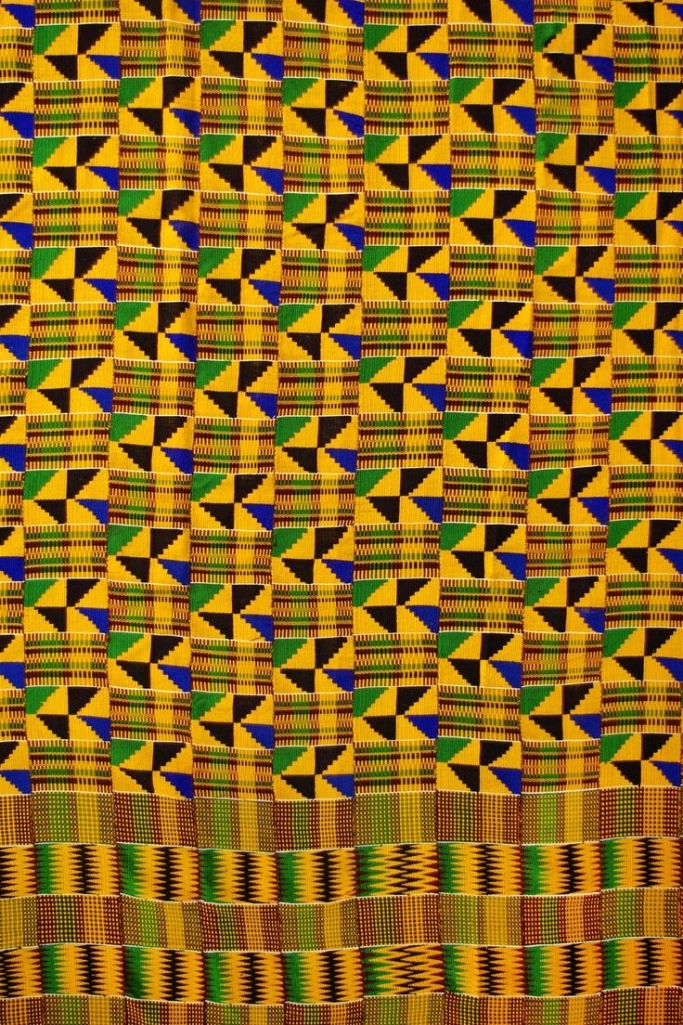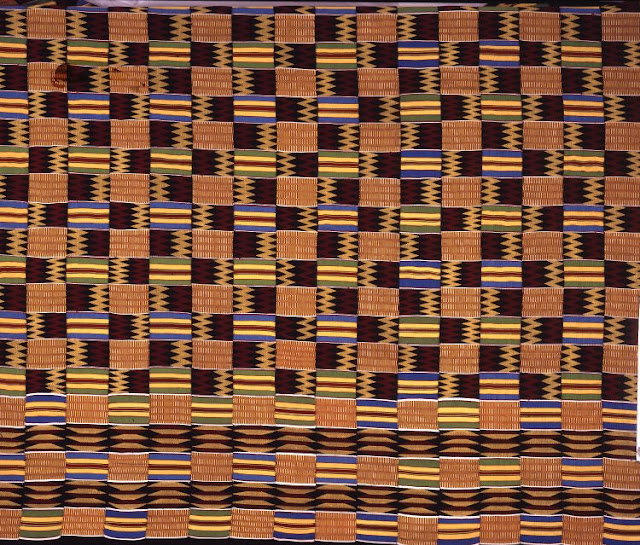 Kente inspired dress by Victoria Pettersson Henry source
Kente inspired dress by Victoria Pettersson Henry source
Kente weaver, photo courtesy Patrick Smith
 Kente, 1970-1990, silk. The pattern on this kente is known as Puduo or Kuduo, which was a pyramid-shaped brass container used in rituals to sustain the family. The Indianapolis Museum of Art Close up below
Kente, 1970-1990, silk. The pattern on this kente is known as Puduo or Kuduo, which was a pyramid-shaped brass container used in rituals to sustain the family. The Indianapolis Museum of Art Close up belowIn most kente cloths the design effect is achieved by alternating regularly positioned blocks of pattern in bright-coloured silk with the more muted colours of the warp-striped plain weave background. Interestingly, each kente has a distinctive name and it is exactly the background design that provides the name. One of the most popular designs featuring red, green and gold stripes is named after the lineage of the Ashanti king. Some of the names refer to the leaders of the past or to the persons for whom the designs were first woven. Others refer to historical incidents, to household objects or to proverbs. For example, pattern with red, green and blue stripes on a yellow warp is named "if you climb a good tree you get a push" - meaning if your intentions are good people will help you. There is also design named "he has become rich", it is supposed to be worn only by men who had more than a thousand pounds worth of gold dust. Marriage kente often have motifs symbolizing life-affirming messages such as "extended family is strong."
Silk kente, 1947 The British Museum Close up below
 Ashanti Kente Cloth Gregg Museum of Art and Design
Ashanti Kente Cloth Gregg Museum of Art and Design
Silk kente, 1900-1950 The Indianapolis Museum of Art
Cotton, rayon and silk kente, mid 1900s The Indianapolis Museum of Art Close up below
The pattern on this kente, known as Aberewa Ben, was named for a spiritually strong woman of the Asensie clan. 1930-70 cotton, silk The Indianapolis Museum of Art
The wearing of kente is typically reserved for formal occasions when high status festive dress is required. Designers all over the world get inspired by stunning kente prints using them in all kinds of clothing items as well as accessories.

Kente inspired dress Zanjoo
 Kente mini dress source
Kente mini dress source
Kente platform shoes by Dionne Gooding
 Kente inspired bangles and shirt, both by Victoria Pettersson Henry source
Kente inspired bangles and shirt, both by Victoria Pettersson Henry source
Kente inspired bag source
Kente vest KLKC Collections
Related posts
If you enjoyed this post please like my page on Facebook. Thank you!














Two Kente posts in a week, talk about great minds thinking alike. I've been Googling since I bought my dress, there really are some gorgeous things out there. xxx
ReplyDeleteThose prints really leap out at you. I love reading the history behind prints and textiles. Fascinating that they all have names. And so interesting to see how specific styles of dressing and traditions then seep into mainstream design.
ReplyDeleteLook at that! A picture from the Indianapolis Museum of Art, right in my city! We do have many nice international items there I have visited many times. Such an interesting history. I started to think if we made them today with the meanings attach what the modern ones might be. Things about taking good selfies probably :) I would love to be able to wear a garment like those long robes but, sadly, the mocking would be pretty intense. Maybe one day I can live somewhere it will be accepted. Great job lovely friend :) Kisses
ReplyDeleteAll Things Bright and Lovely
Kente, like all traditional attire, can be a source of great inspiration and it is surely to be admired.
ReplyDeleteWow! Very interesting to read about kente. I like the way the traditional cloth and kente print is used as inspiration in modern clothing and accessories :)
ReplyDeleteThanks for sharing this wonderful post with us. If you’re in the fashion retail industry, you know how important it is to offer unique and trendy womens fashion clothes. That’s why I highly recommend Tamooya! Their wholesale selection is vast, covering everything from casual wear to sophisticated outfits, all at great prices. What I love most is that the clothing feels high-end but still allows me to price it competitively. Tamooya excellent customer service and fast shipping have made them my top choice for restocking my boutique.
ReplyDelete